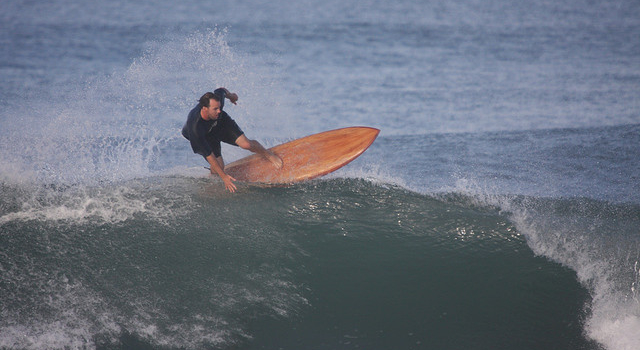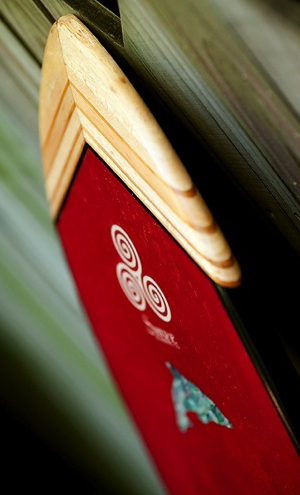What do a countertop company and a surfboard company have in common? Both are run by Ken Trinder, whose novel anti-microbial countertop may soon be seen in hospitals.

A love of surfaces and materials motivates Ken Trinder, who runs both a countertop business, EOS, and a custom-made surfboard company, Shire. As Trinder’s countertops stand poised to enter new markets--a green product just hit Home Depot shelves, and he has hopes that an anti-microbial line will become a hospital fixture--he still finds time to let off steam by surfing and crafting custom boards (which can fetch up to thousands of dollars at auction).
FAST COMPANY: What is it about surfaces that gets you excited? Isn’t that superficial of you?
KEN TRINDER: No, there’s a creative element to both these concepts, making new proprietary types of countertops, and developing and handcrafting surfboards. They start as a hands-on process. There are things I do on the countertop side that tie back directly to things I’ve learned making surfboards. Surfboards are made of resins, and the countertops have resins in them as well, so there’s a tie-in there as far as understanding how those things work and react with each other. I know it sounds like those two things would be the most unrelated things in the world, but it all goes back to the same thing, the chemistry.
EOS has three countertop types, each of which is innovative in its own way.
We had the idea of making a new type of countertop that was polyester acrylic, and we took it upon ourselves to see if we could make it an inch-and-an-eighth thick all the way through. The typical thickness out there is a half-inch. But in the traditional half-inch thickness, you might have four or five hours of labor taking that half-inch sheet, cutting strips off it, and gluing up underneath it to have the illusion of it being an inch-and-a-half thick.
So you offer something that’s thicker and more durable, but you save on labor costs.
In our industry, people always thought something with more product would make it more expensive. But it works out that we can do it in a way that’s price competitive, when you factor in the labor savings.
Your second countertop is GEOS, a green product.
It’s made of crushed recycled glass. That’s been picked up by Home Depot, in the beginning of 2012. We’re seeing strong growth in that product category.
But you’re most excited about your third product.
We created an anti-microbial countertop that just passed EPA testing. There’s not an equivalent thing out there in the marketplace. The countertop will kill all bacteria in under two hours. It basically self-sanitizes. We’re now in the process of registering our public health claims with the EPA; that’s gonna take another seven to nine months.
You’re licensing copper technology from a company called Cupron. How does it work?
It’s been known for a long time that copper is anti-microbial. A specific type of copper compound produces ions that seek out moisture, which is what bacteria and viruses live in. The ions basically overload the cell wall and destroy the RNA. The Cupron folks have perfected getting this technology into textiles. Their CEO and I had a conversation, and I said, “I think we can really take a run at trying to incorporate this into hard surfaces,” and he agreed.
When do you hope to sell to your first hospital?
We hope to do our first installation at the end of summer, beginning of fall. It can take years to plan a hospital. We think the product should be really getting full steam sometime around the end of '13, beginning of '14.
 And how does the surfing tie into all this?
And how does the surfing tie into all this?I grew up on 47th street in Virginia Beach, VA. I don’t remember ever not being near the ocean. I was 6 or 7 when I first started riding waves, and by 10 years old I was fully committed. I’d go travel with my parents and surf all over the planet.
And Shire, your custom surfboard business, is more of a hobby?
It’s a love, a hobby. I don’t do that many boards a year, maybe 10 or 12, and usually I give up half of those to charity. It’s a good mental break for me. It’s a dying craft; I’d say 70% of the world’s surfboards are made on machines.
What’s innovative about your boards?
What I do differently is I try to basically use the most expensive materials I can find--a particular kind of foam, and only carbon fiber cloth, which is used on the hulls of boats and in some airplanes. And all have some element of artistic flair: a shell inlay, or wood. No board’s ever the same; I try to make each as unique as possible.
I spoke with someone who said he learned a lot about building a startup from surfing--that they employ similar skills of timing, anticipation, balance.
I’ve never heard that analogy! You usually hear the opposite: how surfing ruined so many good lives, because you just pick up and go--you can’t control when the waves come. If you surf your entire life, you do try to make sure that when a swell does come, you pick up and leave and go surf. It gets harder as you grow older, when wives and kids and startups get in the way.
This interview has been condensed and edited.
For more from the Fast Talk interview series, click here. Know someone who'd make a good Fast Talk subject? Mention it to David Zax.
Follow Fast Company on Twitter.
DIGITAL JUICE
No comments:
Post a Comment
Thank's!